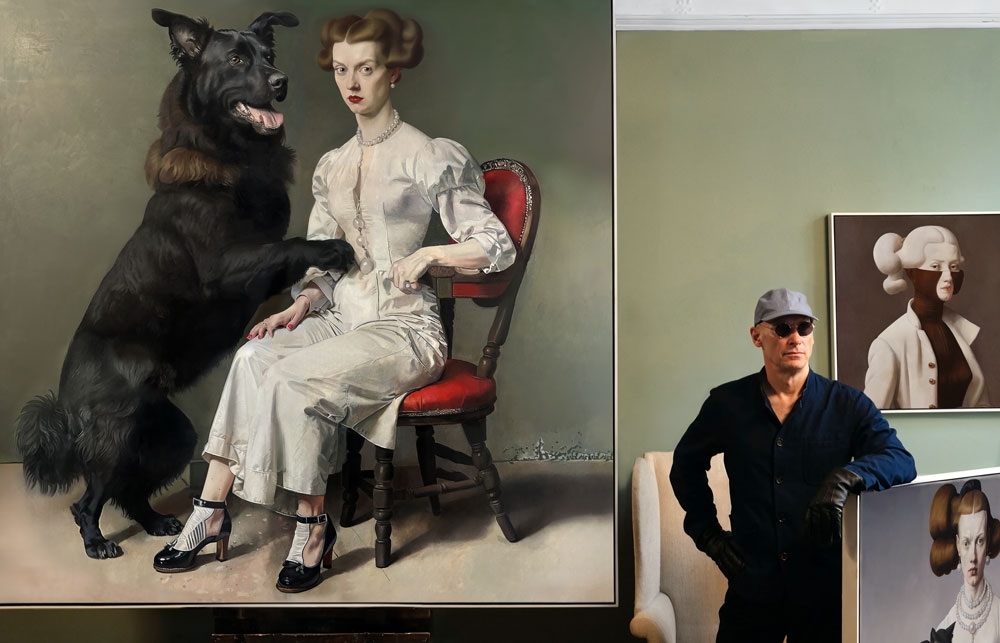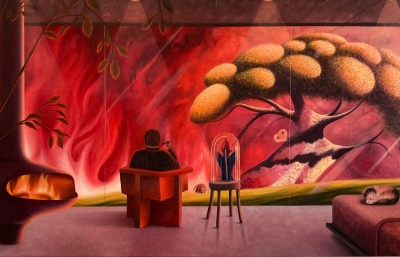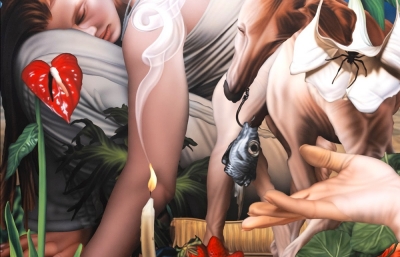Von Wolfe
A Supermodern Romantic
Interview by Evan Pricco // Portrait by the artist
I almost did a triple take during a recent conversation with a colleague as we considered being nearly a quarter of the way through the 21st century and realized that all things we imagined as the future are both fact and fiction. No flying cars yet, but is there any escaping a conversation without a mention of AI and ChatGPT as technology subsumes itself into our daily lives? Those of us of a certain age are inevitable creatures of a particularly incredible life of time-travel, adaptable to both the increasing presence of artificial intelligence and the comfy analog nature of our past.
The British painter Von Wolfe is the living embodiment of this dichotomy, an obsessive researcher of the past, an oil painter who would have found peers in the 19th century but has come to define a process and progress only seen in the 21st. What I first saw as splendidly offbeat paintings in the likeness of John Currin evolved into something far more reaching in its pursuit of newness and unexplored territories in image-making.

Before this interview with Von Wolfe, trying to make sense of his process, I read an illuminating characterization of the work, where his paintings are described as "a fusion of historical elements and contemporary trends merging traditional oil painting techniques with cutting-edge technologies, utilizing algorithmic diffusion models and node-based AI systems... a bridge between disparate eras transcending historical limitations." I wanted to know more. With a new solo show in Los Angeles at Richard Heller Gallery on through March 23, 2024, we sat down with Von Wolfe to find that both innovation and tradition were in his blood.
Evan Pricco: I first have to ask how you discovered you were a direct descendant of Baron von Schlossberg, who was best known as the court painter to King Ludwig II of Bavaria. Evidently, painting is in your blood!
Von Wolfe: My family recorded that his gravestone in Frankfurt am Main bears the title Baron von Schlossberg, and we own paintings by him. Consequently, I grew up hearing stories about the frescoes in Neuschwanstein Castle. Discovering my lineage as a direct descendant of Baron von Schlossberg was quite an intriguing revelation. It certainly adds a layer of historical depth to my artistic journey. Indeed, having such a connection to a court painter for King Ludwig II of Bavaria, known for his patronage of the arts, seems to affirm a kind of inherited affinity for painting. This lineage, while fascinating, is more a curiosity in the backdrop of my personal and artistic growth, a subtle nod to a legacy of artistic endeavor in my family's history.

It seems like you must have been influenced, in some ways, or attracted to, German Romanticism. What era do you find most appealing when re-imagining in a contemporary context?
The intense new philosophy embodied in German art, particularly during the Romantic era, captivated me for its profound exploration of emotion and individualism. This philosophy, characterized by the works of artists like Casper David Friedrich and Otto Runge and shaped by Goethe's color theory, delved into the depths of human experience and perception, emphasizing a profound connection to nature and the sublime.
This historical philosophy bears a significant relationship to today's contemporary art scene. In contemporary art, there's a resurgence of interest in exploring deep emotional landscapes and questioning individual perception, much like the German Romantics did. The exploration of subjective experience, a hallmark of Romanticism, resonates strongly in contemporary practices, where artists often focus on personal narratives and emotional authenticity.
Moreover, the German Romantic emphasis on nature and the sublime finds echoes in contemporary art's engagement with environmental issues and the exploration of the human-nature relationship. The philosophical underpinnings of German Romanticism, with their focus on introspection and a deepened awareness of the human condition, continue to influence and shape the thematic and conceptual frameworks of contemporary artists, creating a bridge between the intense philosophical explorations of the past and the diverse, nuanced artistic expressions of today.
While I like German Romanticism and French Neo-classicism my artistic interests span a broader spectrum. I'm particularly drawn to eras rich in artistic character, such as the Renaissance and the Netherlands School of the 16th century. These periods provide a wealth of stylistic and thematic elements ripe for reinterpretation in a contemporary context. By integrating these historical elements with the emotive depth of German Romanticism, I create a tapestry of work that is both deeply rooted in history and distinctly modern.

Let's dive into your work, which possesses a truly unique style and method. I want to know about technique and how a Von Wolfe painting is made. Walk me through the steps.
My painting process is a meticulous amalgamation of traditional and digital techniques. It begins with the generation of ideas through AI algorithms, a process akin to planting seeds in a digital Petri dish. From these initial concepts, I select the most compelling and unique images, focusing on those that challenge or intrigue. The next stage involves the traditional craft of painting—transferring these digital visions onto canvas using oil paints. This blend of technology and handcrafting ensures each piece is not just a reproduction but a reinterpretation imbued with a distinct personal touch and artistic sensibility.
When did this style emerge in your practice, and when did you begin to approach painting this way?
The genesis of my current style can be traced back to a specific phase in my artistic development. It emerged as a natural progression from my earlier practices, evolving over time as I explored various mediums and techniques. This approach represents a maturation of my artistic vision, one where I've found a harmonious balance between the traditional and the technological, the historical and the contemporary.
How do you choose your subjects?
The subjects of my paintings are as diverse as the influences that inspire them. They often emerge from a rich tapestry of historical, cultural, and artistic narratives. Some are rooted in classical themes or figures, reimagined in a contemporary context, while others might be more abstract, born from the interplay of AI-generated ideas and my own creative interpretations.
Artists have utilized new technologies for centuries, and yet it seems there has been pushback in recent years about implementing them and utilizing the tools of the era for a better work or the result an artist wants. Why do you think there has been so much pushback?
The integration of technology in art, while not new, often meets resistance due to a perceived threat to traditional methods. This pushback might stem from a fear of the unknown or a reluctance to embrace change. Historically, every major technological advancement in art, from oil paints to photography, has faced initial skepticism before being accepted as a legitimate tool in the artist's arsenal.

What criticisms do you hear about your method?
Criticisms I encounter often revolve around the authenticity and originality of works created with AI assistance. Some view this approach as diluting the artist's individual touch. However, I see technology as an extension of the artist's toolkit, a means to broaden the horizons of creative expression, not a replacement.
Have you found contemporaries in London who approach painting like you do?
London's contemporary art scene is vibrant and diverse, with many artists experimenting with novel methods and perspectives. While I have encountered contemporaries who embrace technology and innovation in their work, my particular blend of AI integration and traditional painting seems to occupy a unique niche. It's this individual approach that defines my work within the broader context of contemporary art.
While you have a unique and contemporary way of making art, you clearly embrace the medium of oil paint.
Despite the technological aspects of my process, the allure of oil paint remains strong. Its tactile nature, depth of color, and versatility offer a sensory and aesthetic experience that is irreplaceable. Oil paint connects me to centuries of artistic tradition, providing a tangible link to the past even as I explore the possibilities of the future.

Richard Heller is hosting a solo show of work right now. What did you have planned for it?
The show with Richard Heller will be in 2024, and I’m planning a collection that encapsulates the essence of my artistic journey. It will showcase the unique synthesis of historical influences and contemporary technology that characterizes my work. The exhibition aims to be not just a display of artworks but an experience that reflects the multifaceted nature of my artistic exploration. Through this show at Richard Heller, I aspire to offer a glimpse into what the future of art could hold while paying homage to the rich artistic traditions of the past.
Von Wolfe’s solo show with Richard Heller Gallery in Santa Monica will have an opening on March 2, 2023 and be on view through March 23, 2024.
This interview was originally published in our SPRING 2024 Quarterly






